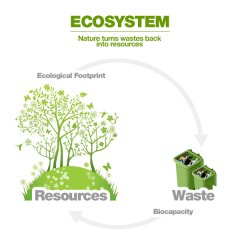Ecological footprint examples
The Ecological Footprint is an indicator that measures a nation’s impact on Earth and its natural systems, indicating whether a country and its people are living sustainably or harming the planet. It does this by comparing our consumption of natural resources with nature’s ability to renew those resources.
The Ecological Footprint can be used to measure consumption patterns for a country, a city, a business, or an individual. In this instance, we're talking about Ecological Footprints on a national level.
Footprint – net consumption
Our footprint is related to our net consumption of natural resources and follows a simple equation: everything we produce locally, plus what we import, minus what we export.
EF consumed = EF produced + EF imported – EF exported
Each nation is responsible for everything it consumes within its borders including the products imported for consumption within the country. The Footprint of products that are exported out of the country (such as oil and gas) is attributed to the countries that consume it. For example, if Japan is consuming UAE oil, then all the energy required to extract, process, transport and burn the oil is part of Japan’s Ecological Footprint (and taken away from the UAE’s Footprint). Any oil/gas that we consume locally, is attributed to our own Footprint.
Ecological Footprints are measured at the point of consumption. For example, when our power stations produce electricity for our homes, they burn gas and release carbon dioxide emissions into the atmosphere impacting our nation’s carbon Footprint. However, as we consume this electricity while watching TV, using our ACs and lights, then that portion becomes part of our individual Footprint (and our responsibility). The power station would only be responsible for the energy that it consumes on the site.
Footprint and biocapacity - supply and demand
To calculate the Footprint, we need to compare the demand on natural resources - which is what we call the Footprint - with the supply of natural resources, which is what we call the Biocapacity.

Let’s dive a little bit deeper into this concept...
Our planet has unique ecosystems that absorb the waste that we produce and turn them back into useable resources. For example, forests absorb our carbon ‘waste’ and store it as wood for our consumption. Thus, biocapacity is the ability of any given ecosystem to produce natural resources for human consumption, while also absorbing the waste materials that the population generates. This is a balance that varies from nation to nation as every country has different types of ecosystems, natural resources, and generates different levels of waste. For example, a country like Brazil with its rich and diverse rainforests will have a much higher biocapacity than the UAE, where we live in a much less productive desert environment.

|
Innate Meta Air Traveller Combo, Small and Large Sports (Innate)
|